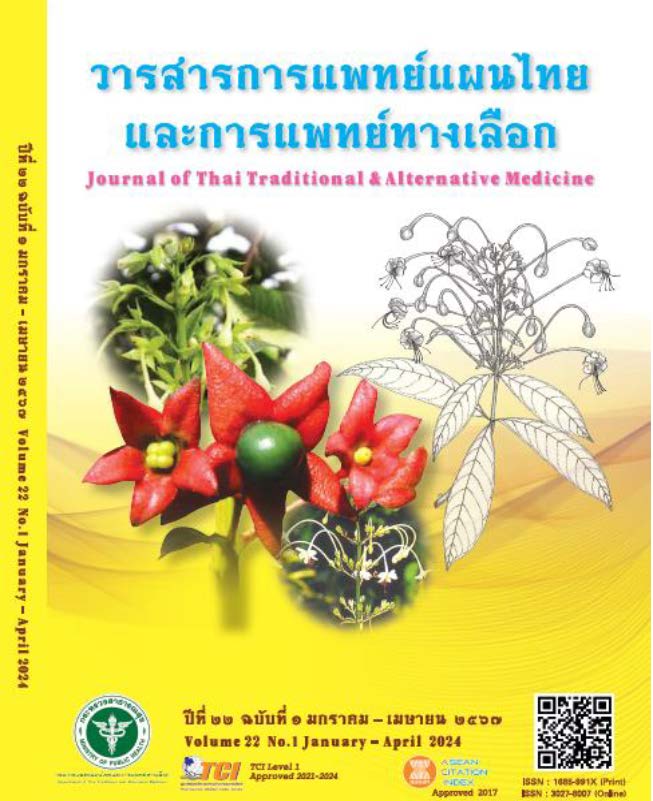การปรับปรุงการเพาะเลี้ยงเนื้อเยื่อรากกัญชาเพื่อผลิตสารสำคัญ
Main Article Content
บทคัดย่อ
บทนำและวัตถุประสงค์ กัญชา (Cannabis sativa L.) วงศ์ Cannabiaceae มีการนำรากมาใช้เพื่อรักษาโรค ซึ่งในการปลูกกัญชาในธรรมชาติต้องใช้เวลานานสารสำคัญอาจน้อยและพบการปนเปื้อนของจุลินทรีย์และโลหะหนักจากดิน งานวิจัยนี้มีวัตถุประสงค์เพื่อผลิตรากกัญชาด้วยการเพาะเลี้ยงรากลอยเพื่อลดปัญหาข้างต้น
วิธีการศึกษา นำเมล็ดกัญชามาฟอกฆ่าเชื้อ เลี้ยงบนอาหารแข็งสูตร Murashige and Skoog (MS)
จนได้ ใบเลี้ยง ใบจริง และราก แล้วนำชิ้นส่วนดังกล่าวมาเลี้ยงบนอาหารแข็งสูตรต่าง ๆ จำนวน 6 สูตร เพื่อหาสูตรอาหารที่เหมาะสมต่อการเกิดราก จากนั้นย้ายรากที่ได้จากการเพาะเลี้ยงในอาหารแข็งมาเลี้ยงต่อในอาหารเหลว
ผลการศึกษา สูตรอาหารแข็งที่ดีที่สุดที่ชักนำให้เกิดรากคือ 1.25 ซึ่งเติมสารควบคุมการเจริญเติบโต 6-benzylaminopurine ความเข้มข้น 0.5 มิลลิกรัมต่อลิตร และ 1-naphthaleneacetic acid ความเข้มข้น 1 มิลลิกรัมต่อลิตร และเมื่อนำมาเลี้ยงในอาหารเหลวต่อเป็นเวลา 15 วัน จะได้น้ำหนักแห้งเฉลี่ยของรากที่ได้จากใบเลี้ยง ใบจริง และราก เท่ากับ 0.35±0.36, 0.41±0.15 และ 0.40±0.14 กรัม ตามลำดับ ซึ่งไม่แตกต่างอย่างมีนัยสำคัญ
อภิปรายผล การเพาะเลี้ยงรากลอยของกัญชาด้วยกรรมวิธีและสูตรอาหารดังกล่าว ข้างต้น ลดปัญหาการปนเปื้อนของโลหะหนักและเชื้อจุลินทรีย์ และเพิ่มปริมาณรากได้อย่างรวดเร็ว รวมทั้งพบสารฟรีเดลีน
ข้อสรุป วิธีการดังกล่าวสามารถชักนำให้เกิดรากกัญชาได้ดี ในอนาคตจะใช้วิธีการเพาะเลี้ยงรากลอยในการผลิตรากกัญชาเพื่อนำไปศึกษาฤทธิ์ทางเภสัชวิทยาต่อไป
Article Details

อนุญาตภายใต้เงื่อนไข Creative Commons Attribution-NonCommercial-NoDerivatives 4.0 International License.
เอกสารอ้างอิง
Boonyaprapat N, Chokchaicharoenporn O. Medicinal Plants indigenous to Thailand. Bankok: Prachachon; 1996. 1 (1): p.169-177. (in Thai)
Pichiansunthorn J. Royal Bachelor of Fundamentals of Cannabis Plants, Alternative Medicine Science, Chandrakaom Rajabhat University and the Office of Science, Royal Academy .2019. (in Thai)
Natasha R. David J. and Ethan B. Cannabis Roots: A Traditional Therapy with Future Potential for Treating Inflammation and Pain. 2017;2(1)
Morin-Crini N, .Loiacono S, Placet V, Torri G, Bradu C, Kostic M, Cosentino, Chanet G, Martel B, Lichtfouse E and Crini G. A review Hemp-base adsorbents for sequestration of metalsEnvironmental Chemistry Letters (2019);17:393-408. Available from
https://doi.org/101007/s10311-018-0812-x
Murashige T and Skooge T. A revised medium for rapid growth and bioassays with tobacco tissue culture. Physiologia Plantarum. 1962;15: 473-497.
George EF, Hall MA, DeKlerk GJ. Plant growth regulators II: cytokinins, their analogues and antagonists. In: George EF, Hall MA, DeKlerk GJ (Eds.), Plant Propagation by Tissue Culture. Springer, Netherlands. .2008.: 205-226.
Jarzina AS. Pontka A. and Kaczmarek Z. Influence of Cultivar, Explant Source and Plant Growth Regulator on Callus Induction and Plant Regeneration of Cannabis sativa L., ACTA BIOLOGICA CRACOVIENSIA Series Botanica 2005; 47/2: 145-151.
Slusarkiewicz-Jarzina A, Ponitka A, Kaczmarek Z. Influence of cultivar, explant source and plant growth regulator on callus induction and plant regeneration of Cannabis sativa L. Acta Biologica Cracoviensia Series Botanica . 2005; 472: 145-151.
Bing X, Ning L, Jinfeng T, Nan G.. Rapid tissue culture method of Cannabis sativa for industrial uses.CN 1887043 A 20070103 Patent. 2007:.9.
Chaohua C, Gonggu Z, Lining Z, Chunsheng G, Qing T, Jianhua C, Xinbo G, Dingxiang P, Jianguang S. A rapid shoot regeneration protocol from the cotyledons of hemp (Cannabis sativa L.). Industrial Crops and Products. 2016; 83: 61-65.
Ferreira l. Studies on the development of callus culture of Cannabis sativa L. Regarding plant regeneration. Instituto Superior Tecnico, Lisboa, Portugal, 2018.
Pranitch B. and Benyakan P. Factors affecting micropropagation of Cannabis sativa L. Pharmarceutical Sciences Asia 2020; 47(1): 21-29.
Roy a. and Bharadvaja N. Establisment of root suspension culture of Plumbago zeylanica and enhanced production of plumbagin.2019; 137: 419-427.
Ruang rak E, Arunruang P and Waesalaemae N. Effect of Friedelin Extract from Cannabis Roots on Cosmeceutical Application. Department of Science, Faacuty Science and Technology, Songkla University. 2022; 147-150.


